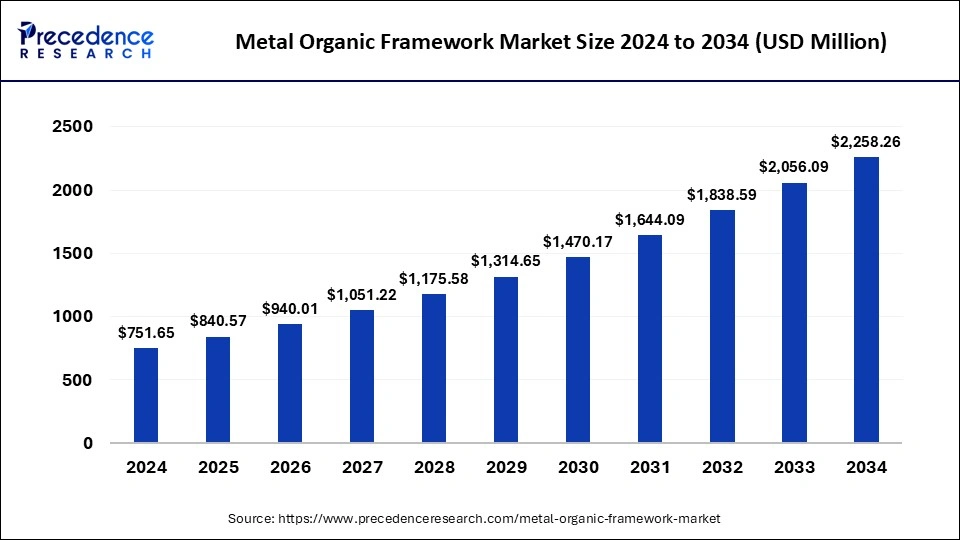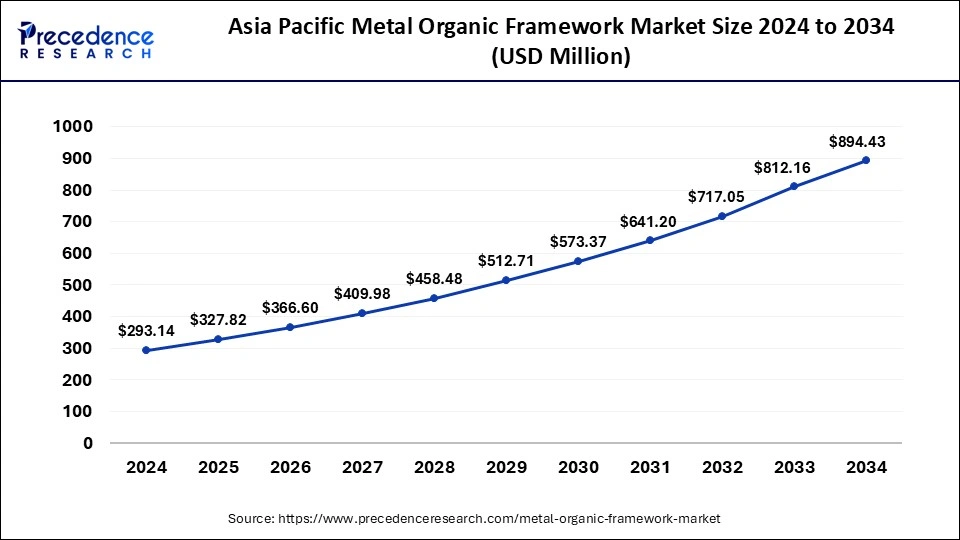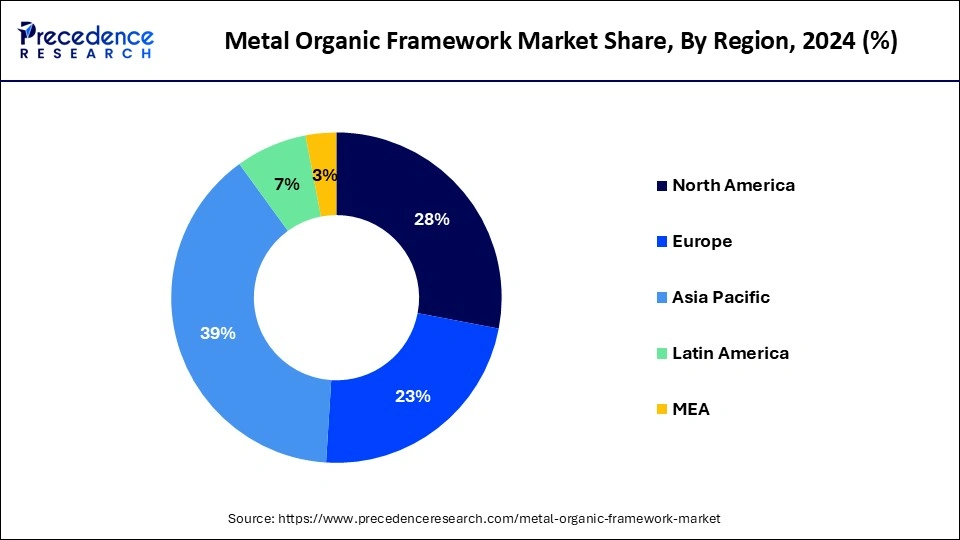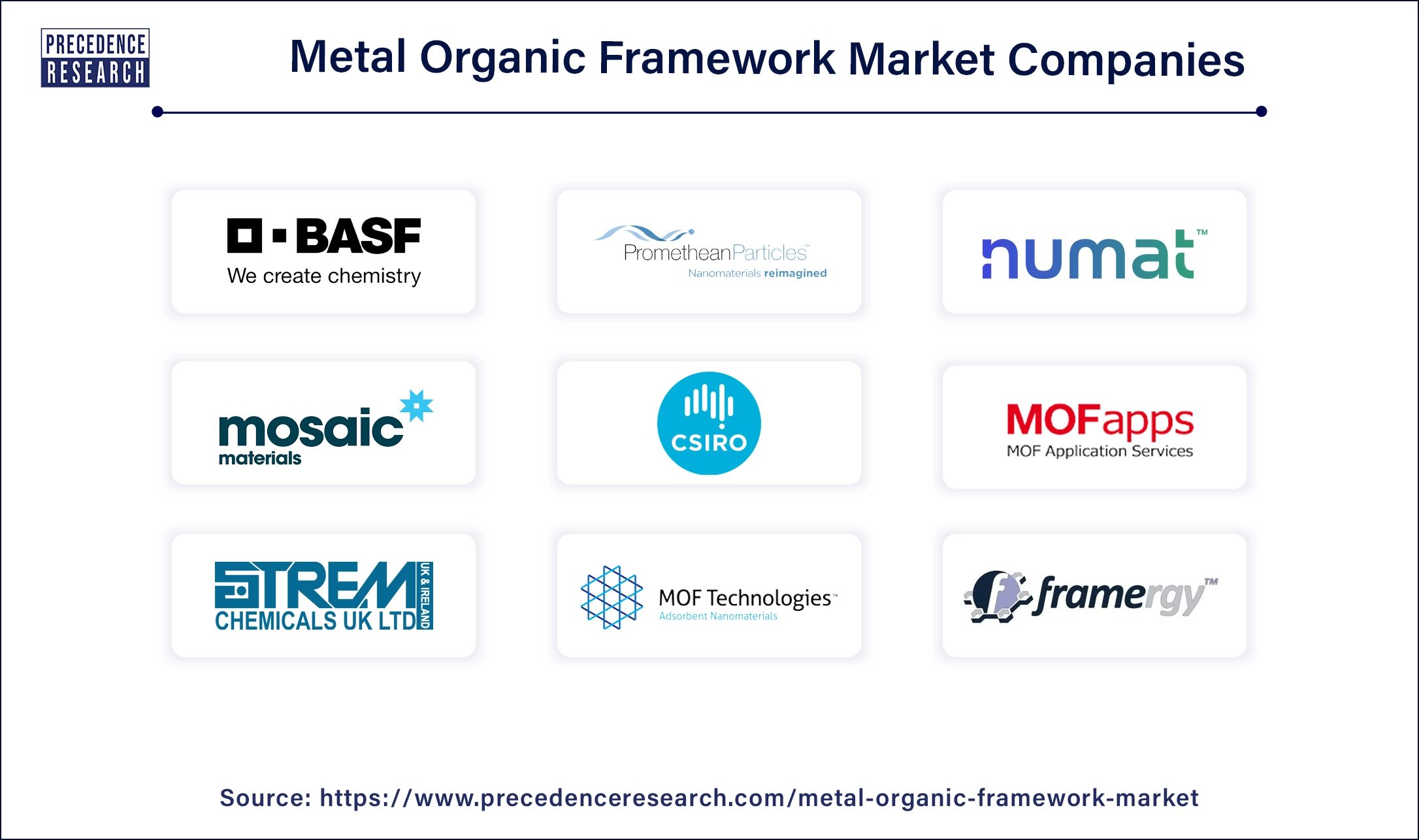April 2025
The global metal organic framework market size is calculated at USD 840.57 million in 2025 and is forecasted to reach around USD 2,258.26 million by 2034, accelerating at a CAGR of 11.63% from 2025 to 2034. The North America market size surpassed USD 293.14 million in 2024 and is expanding at a CAGR of 11.80% during the forecast period. The market sizing and forecasts are revenue-based (USD Million/Billion), with 2024 as the base year.
The global metal organic framework market size accounted for USD 751.65 million in 2024 and is predicted to increase from USD 840.57 million in 2025 to approximately USD 2,258.26 million by 2034, expanding at a CAGR of 11.63% from 2025 to 2034. The rising application of metal-organic frameworks for water remediation across the world is driving the growth of the metal-organic framework market.

The Asia Pacific metal organic framework market size was exhibited at USD 293.14 million in 2024 and is projected to be worth around USD 894.43 million by 2034, growing at a CAGR of 11.80% from 2025 to 2034.

Asia Pacific dominated the market in 2024. The growth of this region is mainly driven by the rising demand for copper-based MOFs. Also, the rising initiatives by public and private sector entities for developing the MOF industry are boosting the market growth. The demand for MOFs also increased in China and India due to water remediation and storage of hydrogen, which drives the market growth. Moreover, the rising demand for zirconium-based MOFs for several applications such as anti-cancer activity, drug delivery, bio-sensing, and imaging, which in turn drives the market growth.
The presence of a well-established oil and gas industry in this region increases the demand for MOFs for storage and adsorption applications, which in turn boosts the market growth. Also, the growing use of iron-based MOF for gas storage and separation and catalysis, along with a growing number of partnerships and collaborations for developing MOF for carbon capture, is likely to boost the metal organic framework market growth.
The presence of several market players such as Majd Onsor Fartak, Pale Blue, SyncMOF, Atomis Inc, and some others are constantly engaged in developing a high-grade metal-organic framework and adopting several strategies such as launches, collaborations, and acquisitions, which in turn drives the growth of the metal-organic framework (MOF) market in this region.
The rising initiatives related to research and development of MOF synthesis technologies in countries such as China, India, Japan, South Korea, and some others are likely to boost the market growth in this region. Also, the growing developments in pharmaceutical industries, along with the rising government initiatives related to CO2 reduction, have increased the demand for different types of MOFs, thereby driving the metal organic framework market growth.

North America is expected to grow at the fastest rate during the forecast period. The rising investment from the public and private sectors for developing MOF technologies drives market growth. Also, the rising advancements in science and technology, along with several government initiatives for reducing CO2 emissions, are likely to drive market growth. Also, the growth of this region is mainly driven by rising government initiatives in countries such as the U.S., Canada, Mexico, and others to strengthen the chemical sector. In addition, the rising cases of cancer in this region increases the demand for zinc-based MOF, which, in turn, boosts the market growth.
Moreover, several market players, such as Framergy, Strem Chemicals, Acsynam, Cbana Laboratories, Numat Technologies, and some others, are constantly engaged in developing MOFs and adopting strategies such as launches, collaborations, and acquisitions, which in turn drives the growth of the metal organic framework market in this region.
The metal organic framework market has grown rapidly with developments in the chemical domain. This industry mainly deals in the manufacturing and distribution of MOF for various applications in different industries. Metal-organic frameworks (MOFs) are a new type of emerging crystalline porous solids with three-dimensional (3D) structures composed of multidentate organic molecules and metals. There are various types of MOFs that mainly include zinc-based, copper-based, iron-based, aluminum based, magnesium-based, titanium-based, zirconium-based, nickel-based, and some others. MOFs find applications in gas storage, gas & liquid adsorption, drug delivery, catalysis, sensing, luminescence, and some others. This industry is expected to grow exponentially with the growth in the chemical industry.
| Report Coverage | Details |
| Market Size by 2034 | USD 2,258.26 Million |
| Market Size in 2025 | USD 840.57 Million |
| Market Size in 2024 | USD 751.65 Million |
| Market Growth Rate from 2025 to 2034 | CAGR of 11.63% |
| Largest Market | Asia Pacific |
| Base Year | 2024 |
| Forecast Period | 2025 to 2034 |
| Segments Covered | Type, Application, and Regions |
| Regions Covered | North America, Europe, Asia-Pacific, Latin America, and Middle East & Africa |
Rising use of MOFs for catalytic applications
The MOF industry has experienced immense growth due to several applications. The demand for MOF has increased recently for various catalytic applications. The MOFs are mainly used as heterogeneous catalysts due to several properties such as physicochemical properties, the existence of uncoordinated metal sites and accessible organic sections, the hybrid inorganic/organic structures, porous systems, and the suitable design of drug delivery systems. There are several types of MOFs; the based MOF has the highest potential for photocatalytic and absorption activities due to their bandgap and strong affinity capacities, along with other aromatic species. Thus, the rising use of FE-based MOFs for catalytic activities is likely to drive the growth of the metal organic framework market.
Growing use of MOF in biomedical imaging
There are several developments in medical diagnostics methodologies with the advancements in modern science and technologies. The concept of MOF-related imaging techniques has gained attention recently due to various applications. The MOF-based imaging techniques are mainly used in computed tomography (CT), optical imaging, magnetic resonance imaging (MRI), and positron emission tomography (PET) imaging. Thus, the rising use of MOF-based biomedical imaging for the diagnosis of different parts of the body is likely to drive the growth of the metal organic framework market during the forecast period.
High cost and other complexities
The use of MOF has increased significantly in recent times. Although MOF has several advantages, there are also several problems in this industry. Firstly, the cost of manufacturing MOF is very high as the raw materials prices and labor wages have increased rapidly. Secondly, there are several complexities, such as a lack of scalability and environmentally sustainable manufacturing methods. Thus, the increased cost of MOFs, along with other complexities, is likely to restrain the growth of the metal organic framework market during the forecast period.
Integration of AI and ML for discovering MOFs
The MOF industry has grown rapidly with the developments in chemical sciences and its related fields. The rising integration of AI and ML has gained attention in the MOF industry recently. By using AI and ML technologies, manufacturers can optimize and predict the properties of various MOFs. Thus, the rising use of AI and ML technologies to discover new types of MOFs is expected to create ample growth opportunities for market players in the coming days.
The copper-based segment held the largest market share in 2023. The growth of this segment is generally driven by the rising advancements in the chemical industry around the world. Also, the growing demand for copper-based MOFs to prevent CO2 emissions, along with new developments in copper-based MOFs, boosts the market growth. Moreover, the rising demand for copper-based MOFs due to their novel properties, such as high porosity and thermal stability, along with the rising research and development activities of copper-based MOFs, is likely to drive market growth.
Additionally, copper-based MOFs have special characteristics, such as oxidation states of +1 and +2, which make them suitable for various catalytic activities, which, in turn, drive metal organic framework market growth.
The zinc-based segment is estimated to be the fastest-growing segment during the forecast period. This segment is generally driven by the rising demand for zinc-based MOF for drug delivery. Also, the rising application of zinc-based MOF for skin regeneration to promote wound healing is boosting the market growth. Moreover, several applications of zinc-based MOFs in gas adsorption of medically essential gases and contrast Agents in MRI are driving the market growth.
Additionally, the growing use of zinc-based MOF-based photocatalysts for degrading organic pollutants in water is boosting the market growth. Furthermore, the rising cases of cancer across the world have increased the demand for zinc-based MOF for treatment and diagnosis, which is also driving the growth of the metal organic framework market.
The gas storage segment dominated the market in 2023. The growth of this segment is generally driven by the rising demand for the storage of various gases such as hydrogen, carbon dioxide, and methane. Also, the growth of the market is driven by the growing use of MOF due to its high surface area and porosity for efficient storage. Moreover, the rise in the development of MOFs to revolutionize the energy industry by enabling superior storage options and smoother transportation of natural gas, along with ongoing research and developments related to MOFs for the storage of gases, is driving metal organic framework market growth.
The gas & liquid adsorption segment is expected to grow at a significant rate during the forecast period. This segment is generally driven by the rising demand for MOFs to separate different gases. Also, the growing advancements in MOFs related to the adsorption of gases and liquids are likely to boost the market growth. Moreover, the rising use of MOF for various adsorption applications, as it helps in the removal of inorganic toxic compounds containing heavy metals, is driving the growth of the metal-organic framework market. Furthermore, the rising use of MOFs to evaluate and rank capture performances of CO2 has driven the growth of the metal organic framework market.

By Type
By Application
By Geography
For inquiries regarding discounts, bulk purchases, or customization requests, please contact us at sales@precedenceresearch.com
No cookie-cutter, only authentic analysis – take the 1st step to become a Precedence Research client
April 2025
January 2025
January 2025
September 2024